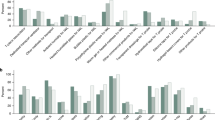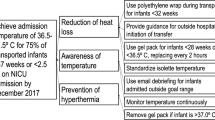Objective
Hypothermia remains a significant problem among very low birth weight (VLBW) infants. The use of occlusive polyethylene plastic bags immediately after birth has been proven to be effective for preterm infants to reduce hypothermia. This study aims to determine whether placing VLBW infants in plastic bags during transport reduces hypothermia.
Study design
Study infants were randomly assigned to a standard thermoregulation protocol or to a standard thermoregulation protocol with placement of the torso and lower extremities inside a polyethylene plastic bag during transport. The primary outcome measures were axillary temperature before and after transport and the occurrence of moderate hypothermia upon neonatal intensive care unit admission.
Result
The 108 VLBW infants recruited into the study were randomized to the plastic bag (n = 54) group or to standard group (n = 54) and had similar baseline characteristics. VLBW infants in the plastic bag group had a lower rate of moderate hypothermia (3.7 vs 27.8%; risk ratio 0.10; confidence interval 0.02–0.46; P < 0.001) and higher axillary temperatures (36.4 ± 0.4 °C vs 35.9 ± 0.9 °C; P = 0.001) upon NICU admission compared to infants receiving standard care.
Conclusion
Placing VLBW infants in polyethylene plastic bags during transport reduces the occurrence of hypothermia, especially moderate hypothermia.
This is a preview of subscription content, access via your institution
Access options
Subscribe to this journal
Receive 12 print issues and online access
$259.00 per year
only $21.58 per issue
Buy this article
- Purchase on Springer Link
- Instant access to full article PDF
Prices may be subject to local taxes which are calculated during checkout
Similar content being viewed by others
References
Lyon AJ, Freer Y. Goals and options in keeping preterm babies warm. Arch Dis Child Fetal Neonatal Ed. 2011;96:F71–F74.
Kumar V, Shearer JC, Kumar A, Darmstadt GL. Neonatal hypothermia in low resource settings: a review. J Perinatol. 2009;29:401–12.
World Health Organization, Department of Reproductive Health and Research. Thermal protection of the newborn: A practical guide. Geneva, Switzerland: World Health Organization; 1997.
McCall EM, Alderdice F, Halliday HL, Jenkins JG, Vohra S. Interventions to prevent hypothermia at birth in preterm and/or low birthweight infants. Cochrane Database Syst Rev 2010;(1):CD004210.
Li S, Guo P, Zou Q, He F, Xu F, Tan L. Efficacy and safety of plastic wrap for prevention of hypothermia after birth and during NICU in preterm infants: a systematic review and meta-analysis. PLoS ONE. 2016;11:e0156960.
Carroll PD, Nankervis CA, Giannone PJ, Cordero L. Use of polyethylene bags in extremely low birth weight infant resuscitation for the prevention of hypothermia. J Reprod Med. 2010;55:9–13.
Cramer K, Wiebe N, Hartling L, Crumley E, Vohra S. Heat loss prevention: a systematic review of occlusive skin wrap for premature neonates. J Perinatol. 2005;25:763–9.
Conde-Agudelo A, Diaz-Rossello JL, Belizan JM. Kangaroo mother care to reduce morbidity and mortality in low birthweight infants. Cochrane Database Syst Rev 2011;(4):CD002771.
McCarthy LK, Molloy EJ, Twomey AR, Murphy JF, O’Donnell CP. A randomized trial of exothermic mattresses for preterm newborns in polyethylene bags. Pediatrics. 2013;132:e135–e141.
Trevisanuto D, Doglioni N, Cavallin F, Parotto M, Micaglio M, Zanardo V. Heat loss prevention in very preterm infants in delivery rooms: a prospective, randomized, controlled trial of polyethylene caps. J Pediatr. 2010;156:914–7.
Leadford AE, Warren JB, Manasyan A, Chomba E, Salas AA, Schelonka R, et al. Plastic bags for prevention of hypothermia in preterm and low birth weight infants. Pediatrics. 2013;132:e128–e134.
Knobel RB, Wimmer JE, Holbert D Jr.. Heat loss prevention for preterm infants in the delivery room. J Perinatol. 2005;25:304–8.
de Almeida MF, Guinsburg R, Sancho GA, Rosa IR, Lamy ZC, Martinez FE, et al. Hypothermia and early neonatal mortality in preterm infants. J Pediatr. 2014;164:271–5.
Chitty H, Wyllie J. Importance of maintaining the newly born temperature in the normal range from delivery to admission. Semin Fetal Neonatal Med. 2013;18:362–8.
Demauro SB, Douglas E, Karp K, Schmidt B, Patel J, Kronberger A, et al. Improving delivery room management for very preterm infants. Pediatrics. 2013;132:e1018–e1025.
Smith J, Usher K, Alcock G, Buettner P. Application of plastic wrap to improve temperatures in infants born less than 30 weeks gestation: a randomized controlled trial. Neonatal Netw. 2013;32:235–45.
Laptook AR, Salhab W, Bhaskar B. Admission temperature of low birth weight infants: predictors and associated morbidities. Pediatrics. 2007;119:e643–e649.
Reilly MC, Vohra S, Rac VE, Dunn M, Ferrelli K, Kiss A, et al. Randomized trial of occlusive wrap for heat loss prevention in preterm infants. J Pediatr. 2015;166:262–8.
Acknowledgements
We thank the nurses and fellows in the NICU, Children’s Hospital of Fudan University for their help with this project. We thank Conway Niu (Department of Paediatrics and Child Health University of Otago, Wellington) for the help in preparing the manuscript.
Funding
The Clinical Research Project was supported by the National Key Research and Development Program (2016YFC1000500).
Author information
Authors and Affiliations
Corresponding author
Ethics declarations
Conflict of interest
The authors declare that they have no competing interests.
Additional information
Conflict of interest
The authors declare that they have no conflicts of interest.
Rights and permissions
About this article
Cite this article
Hu, Xj., Wang, L., Zheng, Ry. et al. Using polyethylene plastic bag to prevent moderate hypothermia during transport in very low birth weight infants: a randomized trial. J Perinatol 38, 332–336 (2018). https://doi.org/10.1038/s41372-017-0028-0
Received:
Revised:
Accepted:
Published:
Issue Date:
DOI: https://doi.org/10.1038/s41372-017-0028-0
This article is cited by
-
Development, implementation, and evaluation of neonatal thermoregulation decision support web application
BMC Medical Informatics and Decision Making (2023)



